Michigan vegetable crop report – June 26, 2024
Vegetables abound as harvest begins to hit its stride this season. Rains are bringing increased disease pressure.

Weather
Many areas in Michigan received more than 2 inches of rain this week. With crops up and growing, this level of precipitation will result in some disease outbreaks. This is a good time to ramp up fungicide programs if you haven’t already. Hail damage on crops has occurred in some areas of west Michigan.
There will be a hiatus in our report’s weekly weather forecast for the time being. Please consult the National Weather Service website or the forecasts accessible through Michigan State University Enviroweather for your area.
Spotted lanternfly
There was a small colony of spotted lanternfly nymphs detected in southern Monroe County in June 2024. Its potential impacts on vegetable systems are a topic for another time, but for now, visit the Michigan State University Spotted Lanternfly website for more information.
Produce Food Safety On-Farm Readiness Reviews
On May 2, the U.S. Food and Drug Administration (FDA) released their final revisions to the Food Safety Modernization Act Produce Safety Rule Pre-Harvest Agricultural Water Rule. If you are a grower in Michigan, this is a great time to schedule an On-Farm Readiness Review (OFRR). Not only can our team help you assess your on-farm produce safety risks, we can help you assess your water system in light of the updated water rule. If you have already had an OFRR on your farm, no problem, we are happy to come back out to help you assess your water system based on the new parts of the water rule.
An On-Farm Readiness Review (OFRR) is an opportunity for a grower to walk around their farm with their local conservation district produce safety technician and a produce safety specialist from Michigan State University Extension. These 2-hour educational visits take place during the harvest season and are meant to be casual and low stress. Everything discussed during an OFRR is confidential and focused on ways a grower can reduce their own risks in relation to produce safety. There is no pressure to take our advice either, we are just here to support you in your produce safety efforts!
Crop updates
Asparagus
The latest harvested fields in west central Michigan were shut down last week after a season of “couldn’t ask for better” weather, while others shut down two weeks back. The focus will shift now to keeping fern healthy to charge up crowns for next year’s harvest.
Protecting fern from foliar disease will be a priority given recent high dew points, warm temperatures and rain. Growers have already been applying fungicides to protect young fields from purple spot and rust. Chorothalonil, azoxystrobin and mancozeb help protect against purple spot, tebuconazole is the main rust-specific tool. Note, in past years azoxystrobin has mainly been used at the final cover, but there is no reason it could not be used earlier as part of a rotation. Prevention is key with foliar diseases; it is not possible to play catchup.
Reactive management is possible for insects with scouting, or insecticides can simply be included in fern sprays. Field edges are the best place to scout as pests are more abundant there. Common asparagus beetle adults, eggs and larvae were present on field edges in ferned out fields earlier this week. A few larger larvae had begun munching fern, and there were decent numbers of eggs waiting in the wings at one location. Larvae defoliate fern and strip the cuticle from stems creating characteristic damage.
Japanese beetle activity had also begun. Japanese beetles feed on cladophylls, stripping them off the branches and damaging them so they turn brownish gray. Adults aggregate along field edges to decorate fern. Finally, tarnished plant bug is mainly a problem when there are new shoots branching into fern; side branches can wither where this sap sucking pest sticks its beak in. Thankfully, there are insecticide options that control this trifecta of pests: the standard combination of carbaryl plus permethrin will control all three; acetamiprid also carries all these pests on the label.
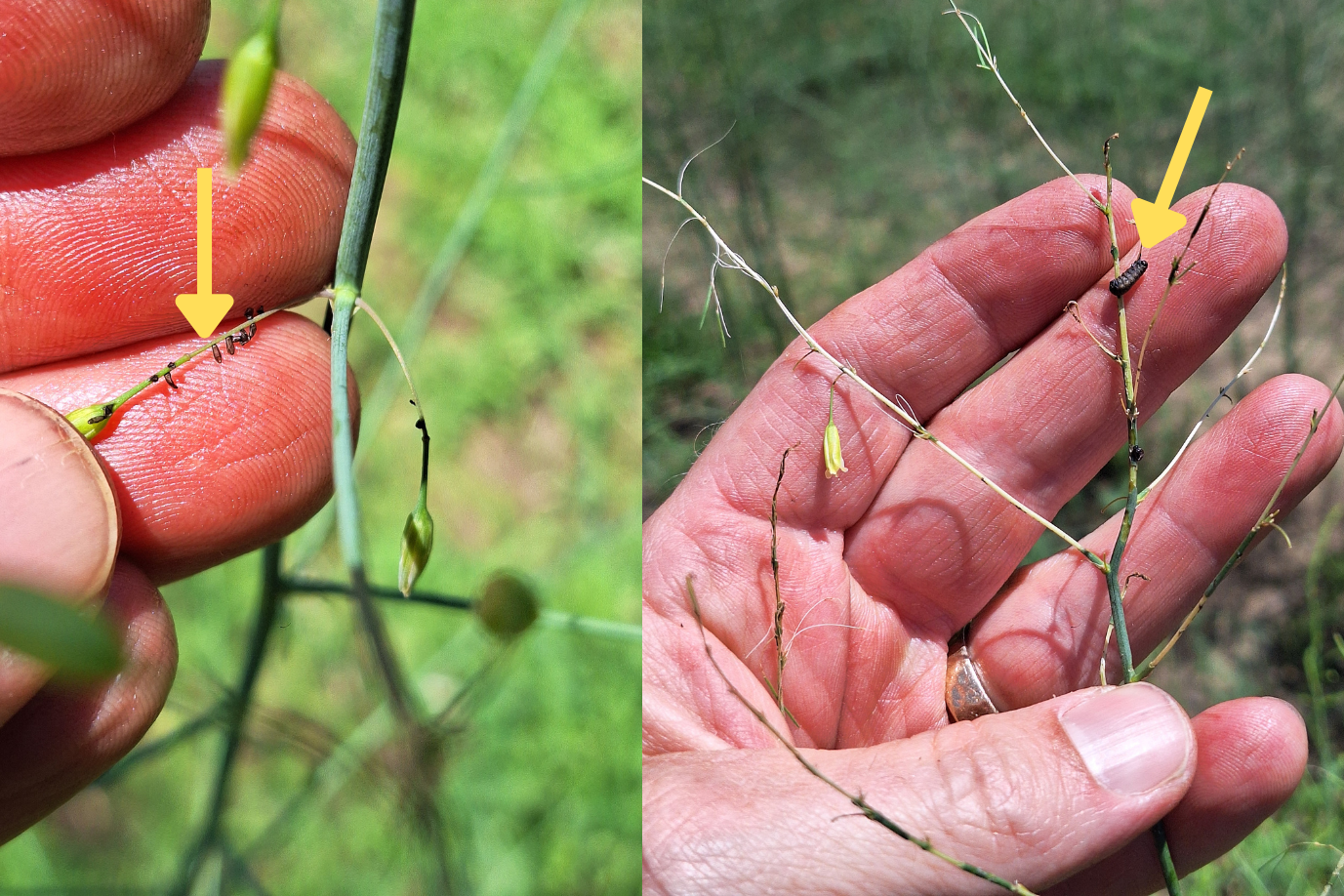
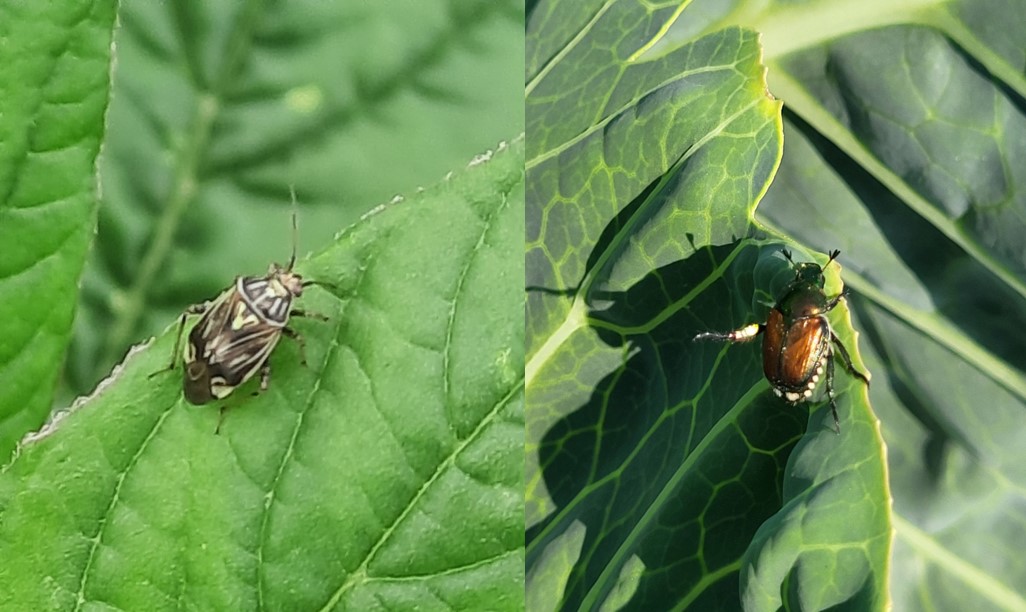
Crabgrass is an aggressive weed but it is possible to target during the fern season. Clethodim can safely be applied in the fern, but it is important to use a good rate, surfactant and water conditioner to maximize effectiveness. On the surfactant front, experience has shown that crop oil concentrate can injure fern in adverse weather. Using a formulation that can be tag teamed with a non-ionic surfactant will reduce the risk of injury. Next spring, growers battling crabgrass could consider applying Solicam (norflurazon) prior to harvest. This herbicide has a very long residual and is dynamite at preventing crab grass issues. It will preclude using a rye cover crop in fall.
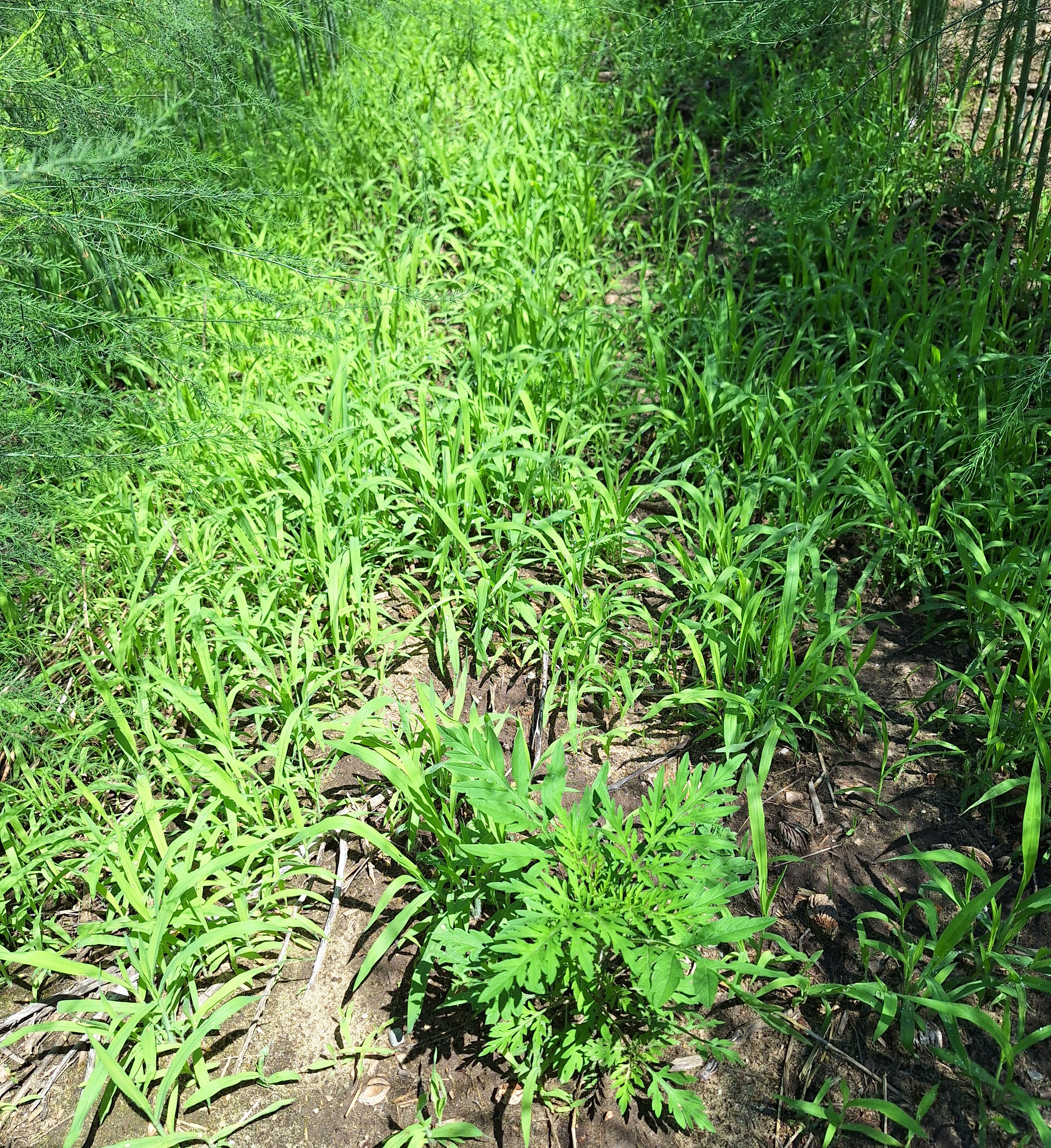
Brassicas and greens
Broccoli, kohlrabi, some cabbage, kale and salad mixes of all types are flowing into markets, while fresh plants are still being planted. All caterpillars and beetles can be found, as well as thrips in some situations. High leafhopper pressure can bring infections from aster yellows.
The first summer peak of cabbage maggot is likely ongoing or coming to an end in west central Michigan. The Michigan State University (MSU) vegetable entomology lab observed maggots on some transplanted brassicas. Thankfully, this time of year plants seem to tolerate maggots without visible damage.
Carrots and celery
Aster leafhopper infectivity has remained high in samples from carrots and celery. Scouts have spotted symptoms on a low percentage of plants in older celery plantings, suggesting grower efforts are not wasted. Carrot growers are also applying Asana to control this pest.
Celery scouts report elevated captures of variegated cutworm moths at some locations. Celery leaftier moths are also present, though caterpillars have not been spotted yet.
First harvests of carrots are underway for fresh market bunching. For information on aster leafhopper thresholds and aster yellow infectivity risk, check out this recent article from Zsofia Szendrei and consider signing up for the text alert system.
Cucurbits
All types of vine crops are being planted, including pumpkins and winter squash. Field-planted cucumbers and summer squash have started going to market throughout Michigan.
Squash vine borer adults may be out and about laying eggs. These secretive and subversive caterpillars come from audacious and brightly colored adult moths that look like wasps and can be seen flying around squash plants like wasps. They are typically most problematic in small plantings. Once eggs are laid at the bases of plants, they quickly hatch and burrow into the stems and become unreachable by any sort of contact insecticides.
You can use the squash vine borer Enviroweather model to figure out when moths are laying eggs. Apply a preventative contact insecticide to manage the emerging caterpillars and, to some extent, the adults as they land on the plants. They only have one egglaying cycle per season. Pyrethroids can provide effective control in conventional cucurbits. For organic growers, spinosad (e.g., Entrust, many other versions) and Bt provided control in some Cornell University research trials. In these trials, products were applied once when moths were first detected, followed by two more applications at weekly intervals.
Cucurbit downy mildew spores were recently detected in a spore trap in Saginaw County. No crop infection has been reported yet. Read “First 2024 cucurbit downy mildew spores identified in air samples in Saginaw County” for more information. Keep up to date on the development of this vegetable disease at the Hausbeck Lab Downy Mildew News website.
Fruiting vegetables
Early field peppers and tomatoes are being picked in small volumes. Bacterial speck has been identified on tomatoes. When it comes to the different caterpillar pests of tomatoes, tomato hornworm is arguably the most infamous. This pest tends to strike early in the morning and in the evening when temperatures are cooler, especially in high tunnel environments. In intensively managed spaces like hoophouses, they can often be sufficiently managed by picking them off by hand when going through to prune, trellis or harvest. There are two distinct hornworm pests of tomato: the tomato hornworm and the tobacco hornworm, distinguished primarily by their side markings. For a refresher on the biology of this pest, check out the MSU Extension article, The tomato hornworm and the tobacco hornworm,” from the archives.
Onions and garlic
Thrips have been active, though the rains this week may slow them down a bit. Garlic leaves are beginning to yellow and die, signaling that the time to harvest is fast approaching. Pulling garlic before 30-50% of the leaves have died back is considered green garlic, which will be smaller and do not dry down as well. As more leaves die back, bulbs are considered mature and will have the best size and quality as dried bulbs.
Some areas are harvesting scapes. As different varieties produce scapes at different times, this can be a drawn out process. Scapes are the stalk and unopened flower bud of the plant as it enters its reproductive stage. Generally, you will want to clip these off to encourage energy to be devoted to bulb development, and they can be sold by the bunch. They are perfectly edible and a favorite among vegetable enthusiasts. Note that softneck varieties typically will not form scapes, though under stressful conditions they may.
Onion foliar pathogens are beginning to show. Unfamiliar with onion diseases? Sending unhealthy plants to MSU Plant and Pest Diagnostics can help those new to the onion disease world develop an accurate eye for symptoms, as visual ID of onion pathogens is difficult and proper identification really matters. Mary Hausbeck has a list of effective products for Botrytis and Peronospora downy mildew, as well as a list of products for Stemphylium.
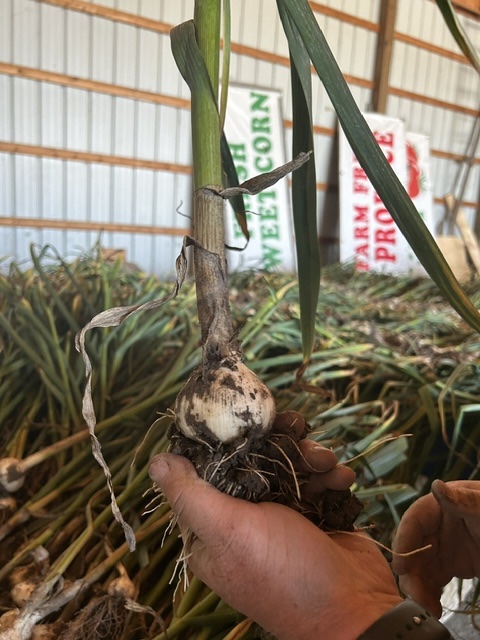
Root crops and potatoes
Radishes, turnips, beets, new potatoes and a slew of other root crops are ready in many areas. Colorado potato beetles can be found in all life stages now, and it may be worth a foliar application of insecticide if you did not use an at-plant treatment. Early blight and hopper burn can be found in potatoes.
Rhizomania is a destructive soilborne disease of red beets. The disease causes infected beets to have a hairy beard of roots, with prolific top growth and a crown with no shoulders. Read more information on Rhizomania symptoms. Resistant varieties are the main way to manage this disease. Currently available varieties include Bazzu, Borealis and Grenade. Limiting movement of soil from infested to non-infested fields may also slow its spread. To do this, consider working in infested fields last and power washing equipment afterwards.
Degree-day models and observations suggest west central Michigan is in the midst or towards the end of the first summer peak of cabbage maggot activity. Eggs and maggots were spotted last week at one west central location. You can get local risk predictions using the cabbage maggot Enviroweather tool, where you can select a local weather station.
Post-plant control of cabbage maggot in direct sown brassicas is difficult. Past trials showed broadcast applications of Mustang Maxx can reduce damage but were far from sufficient to provide standalone protection. Radiant (active ingredient spinetoram) is another product with activity. In Ontario rutabaga trials, Radiant reduced damage when applied as a directed spray aimed at the base of plants. However, experience has shown that broadcast applications do not work—the product needs to get to the plant base. This may require using drop nozzles. It is worth considering experimenting with these before we lose chlorpyrifos again. Greenleaf markets drop nozzles called Belugas that can affix to an existing boom at whatever spacing you desire. It plugs into existing nozzle bodies so plumbing a new line is not needed.
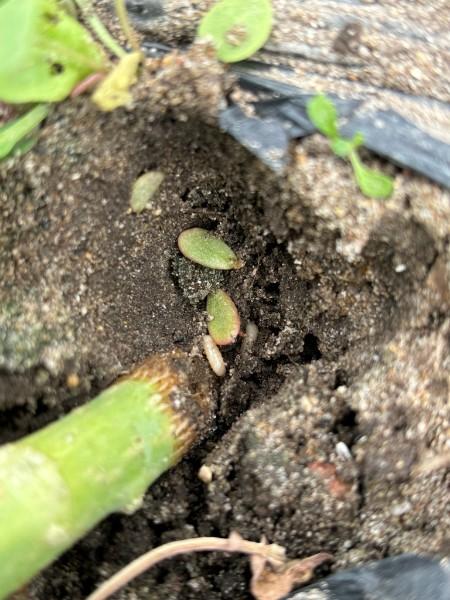
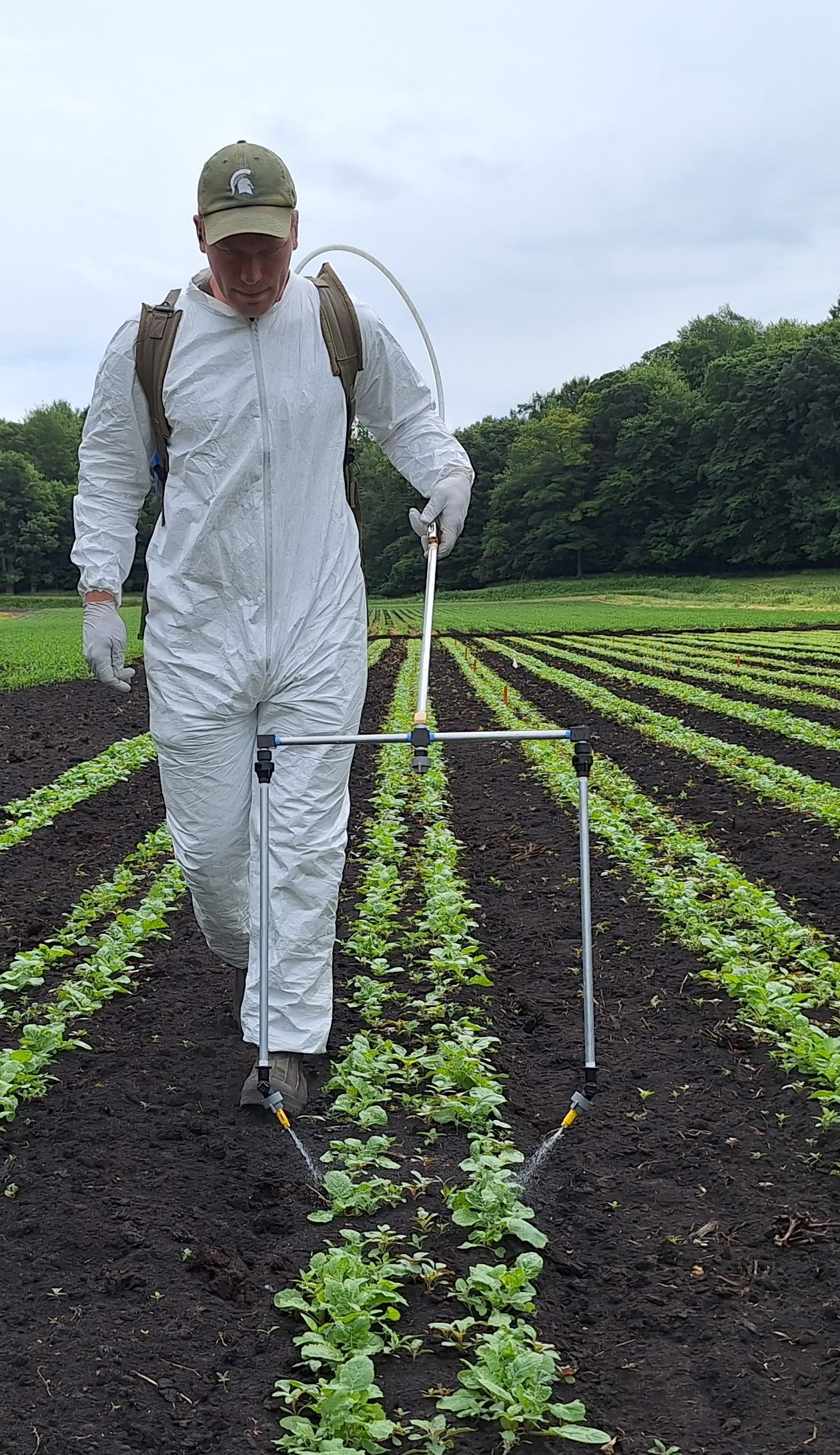
Strawberries
Matted row berries are winding down in some areas. Renovation is next on the schedule before main-season vegetables really kick in.
Sweet corn
It is almost time to start setting traps for sweet corn moths. Early plantings are tasseling, with some just starting to push silks. Consider bookmarking the following websites that provide pest updates:
- Video tutorial on pheromone trapping for corn earworm
- Corn earworm forecaster
- Purdue University Corn earworm trapping network
- Ohio State University C.O.R.N newsletter (check the “lep monitoring network” weekly update)
- Purdue Pest and Crop Newsletter (helpful for black cutworm and armyworm)
Events
- June 27, 7-8 a.m., Field Crops Virtual Breakfast Series: Insect Update Beneficials & Corn Borer
- July 11, 7-8 a.m., Field Crops Virtual Breakfast Series: Wild Weather for Hay
- July 18, 7-8 a.m., Field Crops Virtual Breakfast Series: White Mold - Tar Spot Spraying – Will it Pay?
- July 23, 6-8 p.m., Veggie Vibes at SWMREC
- July 25, 7-8 a.m., Field Crops Virtual Breakfast Series: Hot Topics Q&A Session
- Aug. 1, 7-8 a.m., Field Crops Virtual Breakfast Series: Cover Crops After Wheat
- Aug. 2, 10 a.m.-2 p.m., Organic Inspection Field Day at The North Farm
- Aug. 8, 7-8 a.m., Field Crops Virtual Breakfast Series: MSU Diagnostic Lab Topics
- Aug. 8, Potato Field Day at the Montcalm Research Center, Lakeview, MI
- Aug. 12, Small Farms Conference, Benzonia, MI
- Aug. 13, Farming for the Future Field Day at the West Central Michigan Research and Extension Center, Hart, MI.
- Aug. 15, 7-8 a.m., Field Crops Virtual Breakfast Series: Field Crops Nematode Update
- Aug. 20, 6-8 p.m., Veggie Vibes at SWMREC
- Aug. 20, Bean and Beet Day at the Saginaw Valley Research and Extension Center, Frankenmuth, MI
- Aug. 22, 7-8 a.m., Field Crops Virtual Breakfast Series: Lime Recommendations for Field Crops
- Aug. 22, Summer Bus Tour and Annual Field Day at the Northwest Michigan Horticulture Research Center, Traverse City, MI
- Aug. 29, 7-8 a.m., Field Crops Virtual Breakfast Series: Maximizing Wheat Yield Potential
- Sept. 5, 7-8 a.m., Field Crops Virtual Breakfast Series: Drought-Proofing Agriculture with Drainage Water Recycling
- Sept. 5, Long-Term Agroecosystems Research Field Day at the W. K. Kellogg Biological Station.
- Sept. 12, 7-8 a.m., Field Crops Virtual Breakfast Series: Grain Marketing
- Sept. 17, 6-8 p.m., Veggie Vibes at SWMREC
- Sept. 19, 7-8 a.m., Field Crops Virtual Breakfast Series: Late Season Weed Control
- Sept. 23, Field Day at the Trevor Nichols Research Center, Fennville, MI
This work is supported by the Crop Protection and Pest Management Program [grant no. 2021-70006-35450] from the USDA National Institute of Food and Agriculture. Any opinions, findings, conclusions, or recommendations expressed in this publication are those of the author(s) and do not necessarily reflect the view of the U.S. Department of Agriculture.



 Print
Print Email
Email

